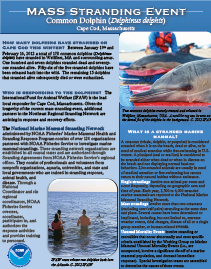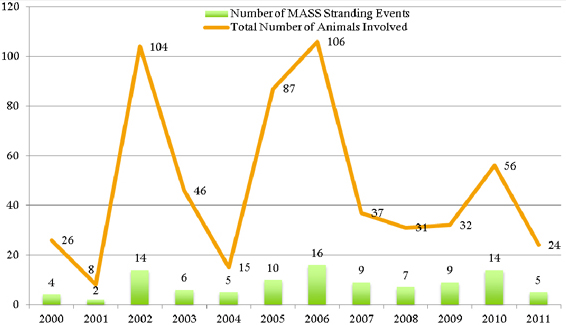2012 Mass Stranding of Common Dolphins (Delphinus delphis) on Cape Cod, MA
 Printable Fact Sheet [pdf] |
|
What is a stranded marine mammal? A cetacean (whale, dolphin, or porpoise) is considered stranded when it is on the beach, dead or alive, or in need of medical attention while free-swimming in U.S. waters. |
|
How many dolphins have stranded on Cape Cod this winter?
From January 12-February 16, 2012, a total of 178 common dolphins (Delphinus delphis) have stranded in Wellfleet, MA and surrounding areas:
- 107 dolphins stranded dead
- 71 stranded alive
- 56 of the live stranded dolphins have been released (53 successfully) back into the wild
- 15 dolphins that stranded alive subsequently died or were euthanized
Who is responding to the dolphins?
The International Fund for Animal Welfare (IFAW) ![]() is the lead local stranding network responder for Cape Cod, MA. Given the longevity of the current mass stranding event, additional partners in the Northeast Regional Stranding Network are assisting in response and recovery efforts.
is the lead local stranding network responder for Cape Cod, MA. Given the longevity of the current mass stranding event, additional partners in the Northeast Regional Stranding Network are assisting in response and recovery efforts.
The National Marine Mammal Stranding Network administered by NOAA Fisheries' Marine Mammal Health and Stranding Response Program consists of over 120 organizations partnered with NOAA Fisheries Service to investigate marine mammal strandings. These stranding network organizations are established in all coastal states and are authorized through Stranding Agreements from NOAA Fisheries Service's regional offices. They consist of professionals and volunteers from nonprofit organizations, aquaria, universities, and state and local governments who are trained in stranding response, animal health, and disease. Through a National Coordinator and six regional coordinators, NOAA Fisheries Service oversees, coordinates, participates in, and authorizes the response activities and provides training to personnel.
How does this stranding event compare to previous mass stranding events on Cape Cod?
Mass strandings of cetaceans have historically occurred for centuries around Cape Cod with some level of frequency.
The Cape Cod area is recognized as having the highest rates of mass strandings nationally.
The three primary cetacean species that have routinely stranded in the area include
- common dolphins (Delphinus delphis)
- Atlantic white-sided dolphins (Lagenorhynchus acutus)
- long-finned pilot whales (Globicephala melas)
There are several different theories about the causes of cetacean mass strandings around Cape Cod, including natural causes such as:
- extreme weather and oceanographic conditions that push the animals inshore
- the strong social bonds of the animals that can lead entire groups to become trapped by tidal fluctuations when they follow prey, or a single sick or geriatric individual inshore
- geo-magnetic anomalies unique to the Cape that may impact the animals' abilities to navigate

Figure 1: The number of cetacean mass stranding events in Massachusetts per year associated with the total number of marine mammal strandings involved in mass stranding events for that year (data represent 7 species of cetaceans).

Figure 2: The number of animals involved in mass stranding events in Massachusetts per year for the three cetacean species that most frequently mass strand: common dolphins (Delphinus delphis), Atlantic white-sided dolphins (Lagenorhynchus acutus) and long-finned pilot whales (Globicephala melas).
However, the current mass stranding event is the largest mass stranding event documented in the Northeast Region over the last 20 years due to the number of animals involved and the length of time over which the strandings have been taking place.
Why do marine mammals strand? In many stranding cases, the cause of stranding is unknown, but some identified causes include:
|
|
What is being done to investigate the cause of these strandings?
IFAW Marine Mammal Rescue and Research team, in consultation with NOAA Fisheries and assisted by Stranding
Network partners, are investigating the situation thoroughly and are analyzing data and samples collected from the dolphins to screen for disease, biotoxins, pollution, hearing capabilities of live animals, and other health indicators to evaluate any potential factors (natural or human caused), as well as to evaluate the success of triage and release of live stranded animals.
This information will be extremely valuable in evaluation of the health of this group of dolphins, the potential causes, and the decisions made on the beach for appropriate care and disposition of live stranded animals.
Utilizing rapid and appropriate response with trained personnel, NOAA and its stranding network partners are significantly increasing our understanding of mass strandings and the overall health of marine mammals in the wild. The teams investigating the dolphin strandings are also involved in the investigation into an ongoing Unusual Mortality Event involving harbor seals in New England, so there is close coordination between the two events to look at any potential commonalities.
Are these strandings considered an "Unusual Mortality Event" (UME) ?
Although the recent common dolphin strandings are indeed alarming and require immediate action to save live animals and recover dead animals for necropsy and analyses, there is currently no evidence to suggest this situation is connected to the recent UME declared for harbor seals in New England.
The majority of stranded common dolphins that have been stranding recently on Cape Cod appear to be healthy and there is no evidence yet indicating disease, toxins, or human-caused activities are influencing the animals to strand.
The dolphins may simply be trapped on the inside arm (the Bay side) of the Cape when the tides go out. This particular species--Common Dolphins (Delphinus delphis)--is a pelagic species of dolphin and not used to shallow waters. Once the IFAW rescue team releases the dolphins into deeper water on the ocean side of the Cape, the majority seems to survive (as evidenced by satellite tags showing animals off the coast of Maine). NOAA is monitoring the situation closely with IFAW and other Stranding Network Partners, and is helping to coordinate laboratory analyses to ensure all possible factors are being evaluated and keeping the Working Group on Marine Mammal Unusual Mortality Events informed.
 Two common dolphins recently rescued and released in Wellfleet, MA. A roto tag can be seen on the dorsal fin of the dolphin in the background. Photo Credit: IFAW 2012 |
What happens to the dolphins when they strand?
Members of the National Marine Mammal Stranding Network are trained to respond to stranded marine mammals and have extensive protocols that are followed in these events. As reports of strandings are received, responders are mobilized to verify reports, collect data or perform a live animal assessment.
Level A data is collected on all carcasses.
Fresh carcasses are recovered for necropsy examination and sample collection. Supportive care and a health assessment are performed on all live animals. This includes, but not limited to:
- documenting vital signs
- external examination for wounds or injuries
- examining skin/ body condition
- collection of blood samples for blood analysis
- assessing for signs of stress or shock
If a dolphin is deemed in good health, the dolphin, or a group of dolphins, will be released back into the ocean. Often, satellite tags are attached to one or more animals released in a group to help monitor the movements of the dolphin(s) after release and provide further information about their distribution, health and habitat use.
Are there any indications of human caused impacts on the stranded dolphins?
External observations do not indicate any human interaction (ex: fishery or vessel interactions) that may be contributing to the stranding events. Necropsy examinations have been conducted on recovered carcasses.
Samples collected from those carcasses are being analyzed to screen for:
- disease
- biotoxins
- pollution
- other health indicators to evaluate any potential factors (natural or human caused)
Could military activities (e.g., Navy sonar or exercises) be causing these strandings?
The Navy has not conducted a major training exercise off the coast of Massachusetts or anywhere in the Northeast in the last 24 months.
Some animal welfare organizations have inquired about "Operation Bold Alligator 12" [pdf], which was a combined Navy and Marine Corps training exercise recently conducted off the coast of North Carolina and southern Virginia. No hull mounted active sonar was used during "Operation Bold Alligator 12." Activities conducted during that exercise could not possibly have affected dolphins in the Gulf of Maine and Cape Cod Bay.
 IFAW team release two dolphins back into the Atlantic Photo Credit: IFAW 2012 |
Are dolphin strandings in other areas connected to the mass strandings on Cape Cod?
There have been isolated common dolphin strandings in other areas of the Northeast Region (e.g., Maine, Rhode Island, and New Jersey) during the same time frame as the mass stranding event.
In evaluating tracking data, common dolphins released from Cape Cod have travelled as far north as Maine and as far south as Maryland. NOAA Fisheries Service and the Northeast Region Stranding Network are monitoring these strandings very closely and are prepared to respond to reported live and dead stranding events.
Necropsy examinations have been performed on 5 common dolphin carcasses that have stranded in areas other than Cape Cod. The results are currently pending, but will be compared and analyzed to results collected from dolphins collected during the mass stranding event.
Where can I find more information?
- NOAA/NMFS Marine Mammal Health and Stranding Response Program website
- International Fund for Animal Welfare (IFAW) website

- NOAA/NMFS Northeast Regional Office Marine Mammal Stranding Program website
Suggested Reading:
- Bogomolni, A.L., K.R. Pugliares, S.M. Sharp, K. Patchett, C.T. Harry, J.M. LaRocque, K.M. Touhey and M. Moore. 2010. Mortality trends of stranded marine mammals on Cape Cod and southeastern Massachusetts, USA, 2000 to 2006. Diseases of Aquatic Organisms, 88:143-155.
- Geraci, J.R. and V.J. Lounsbury. 2005. Marine Mammals Ashore: A Field Guide to Strandings (Second Edition). National Aquarium in Baltimore, Baltimore, MD. 371 pp.
- Kirschvink, J.L., A.J. Westphal and A.E. Dizon. 1984. Cetacean live strandings along the North American Atlantic coast; evidence for a geomagnetic influence on pelagic navigation. EOS Trans Am Geophys Union, 65:865.
- Klinowska, M. 1985. Cetacean live stranding sites relate to geomagnetic topography. Aquatic Mammals, 11:27-32.
- Southall, B. L., R. Braun, F. M. D. Gulland, A. D. Heard, R. W. Baird, S. M. Wilkin and T. K. Rowles. 2006. Hawaiian melon-headed whale (Peponocephala electra) mass stranding event of July 3-4, 2004. NOAA Technical Memorandum NMFS-OPR-31. 73 pp.
- Walsh, M.T., R.Y. Ewing, D.K. Odell and G.D. Bossart. 2001. Mass strandings of cetaceans. Pages 83-96 in CRC Handbook of Marine Mammal Medicine (Second Edition). CRC Press, Boca Raton, FL. 1063 pp.
Updated: February 27, 2012